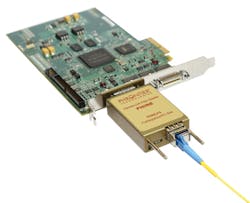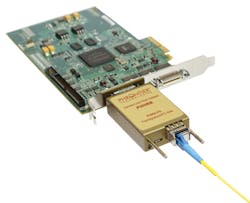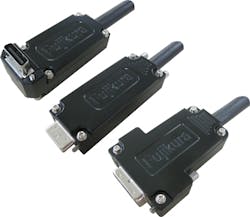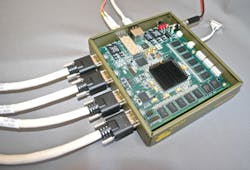Numerous interfaces exist with which to interface cameras to computers. In the machine vision industry, the most popular of these are Camera Link, GigE Vision, USB3 Vision and CoaXPress (CXP), each which exhibit different price/performance tradeoffs. In choosing which interface to adopt, systems designers must carefully balance factors such as image throughput, cost, cable length, future scalability, I/O triggering capability and whether power can be supplied over the cable.
Several articles are readily available that compare these factors including "Choosing the Right Camera Bus," a white paper that can be found on the website of National Instruments (Austin, TX; www.ni.com) at http://bit.ly/1rFqhTT. Although useful, they may only provide an indication of the recommended cable lengths that the standards committees have specified. For example, the maximum cable length of a Camera Link camera to computer cable may be specified at 10m. While this may be true for a passive cable interconnection, there are numerous products available that can extend the camera to computer distance of every standard interface. These prove useful to extend the distance of Camera Link and USB 3 cables and in applications that may require cameras to be deployed in harsh environments or remotely located at distances of over 1km.
Reaching further
To extend these distances, systems developers can choose from a number of products including repeaters, active electrical cables, electrical to fiber converters, active optical cables and standards converters. Repeaters are often offered as stand-alone modules or embedded modules integrated into cables.
Using signal pre-emphasis and equalization techniques, repeaters built for the Camera Link standard can effectively double the 10m standard camera to computer distance. Such stand-alone repeaters are currently offered by a number of vendors including Vivid Engineering (Shrewsbury, MA, USA; www.vividengineering.com), Vieworks (Gyeonggi-do, South Korea; http://machinevision.vieworks.com) and Imperx (Boca Raton, FL, USA; www.imperx.com) and require placement between two cables to increase the transmission distance.
By interfacing embedded repeaters into the cable assembly however, companies such as Components Express Inc. (CEI, Woodridge, IL; www.componentsexpress.com) with its BIT MAXX and Oki (Kawasaki, Japan; www.okidensen.co.jp) with its Clean Eye Camera Link Cable eliminate the need to purchase separate cables and repeaters. Such an approach has also been taken by Newnex Technologies (Santa Clara, CA, USA; www.newnex.com) in the development of the FireNEX-uLINK USB 3.0 active repeater that embeds active circuitry in an enclosure on the length of the cable allowing distances of 12m in length to be achieved.
Embedded connectors
Such pre-emphasis and signal equalization techniques can also be embedded into the connectors of the cables themselves. In the development of a USB3 vision-compliant 15m USB 3.0 active extension cable, CEI and Icron Technologies (Burnaby, BC, Canada; www.icron.com) have developed such a cable branded by Icron as the USB 3.0 Spectra 3001-15 and CEI as the BIT MAXX Extreme USB 3.0. To extend such camera-to-computer distances farther, systems integrators can turn to fiber optic extenders. Depending on the types of transceivers used, distances of high as tens of kilometers can be achieved using these products. While such products are useful in harsh environments, they can be more expensive than active electrical cables.
Like their electrically active counterparts, fiber-optic extenders are offered in a number of different configurations. These consist of stand-alone modules, plug-in modules for cameras and frame grabbers and active optical cables (AOCs). These extenders convert the electrical signals from the camera to optical signals that are then reconverted to electrical signals at the frame grabber.
When first introduced, these products required that electrical cables be used to interface each fiber extender to the camera and frame grabber. Fiber-optic extenders such as the Fiber Link 4000 from Thinklogical (Milford, CT; USA; www.thinklogical.com), for example, support Base, Medium and Full Camera-Link standards and can be used to transmit these signals from 350m up to 10km over multi-mode or single-mode fiber. Such stand-alone converters can also extend the camera-to-computer distances of USB3 Vision-based systems. Newnex's FireNEX-5000, for example, consists of an upstream and downstream converter that allows 100m distances to be achieved using fiber-optic cable.
Recognizing the need to eliminate the electrical cable used to interface Camera Link extenders to cameras and frame grabbers, companies such as EDT (Beaverton, OR, USA; www.edt.com), Phrontier Technologies (Lake Forest, CA, USA; www.phrontier-tech.com) and Intercon1 (Baxter, MN, USA; www.intercon-1.com) have all introduced plug-in converter modules that plug directly into Camera Link cameras and frame grabbers. EDT's RCX C-Link, for example, is similar in size to a Camera Link cable connector and attaches to the MDR26 connector on a camera and frame grabber allowing 100km camera-to-computer distances to be achieved. Similarly, Phrontier Technologies' PHIRE series supports all Camera Link base cameras and frame grabbers up to 85MHz and supports distances to 80km using single mode fiber (Figure 1).
Active optical cables
Taking this concept one step further, a number of companies are now integrating optical transceivers into the connector housings themselves. With the global market for such AOCs projected to surpass US$1 billion by 2018, according to a recent market research report from Global Industry Analysts (San Jose, CA, USA; www.strategyr.com), a number of companies have already introduced such products for the machine vision market to extend the distance limitations of both Camera Link and USB 3 Vision systems.
Using an optical fiber/metal hybrid cable in its latest generation of AOC assemblies, for example, Fujikura (Tokyo, Japan; www.fujikura.co.jp) eliminates the need for external optical repeaters while supporting both Base and Medium Camera Link configurations (Figure 2). Because the cable can transmit power as well as optical signals, PoCL systems can be configured at speeds of 85MHz at up to 100m. Similarly, the USB 3 optical range of cables by Corning Cable Systems (Corning, NY, USA; www.opticalcablesbycorning.com) allow USB 3 peripherals to be connected at speeds of 5Gb/s over distances of up to 50m without requiring an additional power supply.
Interestingly, while many such optical extenders target Camera Link and USB-based systems, the benefits of eliminating any EMI effects while establishing very long camera- to-computer connections also proves useful for standards such as CXP where even 100m (without repeater) cable distances may be insufficient. To meet such demands, KAYA Instruments' (Haifa, Israel; www.kayainstruments.com) CXP Multiplexer over Fiber can simultaneously stream data from up to four CXP camera channels over single fiber. This extends transmission distances up to 10km using single-mode fiber and up to 400m with multi-mode fiber.
Repeaters, active electrical cables, electrical to fiber converters and active optical cables can all be used to extend the distance between cameras and computers. In doing do, they may use signal conditioning and optical conversion techniques while at the same time preserving the protocol of the original interface standard. In some applications, where the benefits of any particular standard may not be important, converting signals from one standard to another may be useful.
Standards conversion
Converting Camera Link to GigE or USB, for example, could be used to eliminate the traditional Camera Link frame grabber required in Camera Link systems. Using GigE or active optical USB 3 cables could then also extend camera-to-computer distances. Indeed, this is the philosophy behind the iPORT Series of products from Pleora Technologies (Kanata, ON, Canada; www.pleora.com) that allow Camera Link cameras to be interfaced to both GigE and 10GigE networks. The iPORT CL-Ten, for example, takes image data from two Camera Link Medium cameras and transfers it at 8 Gb/s to off-the-shelf PCs over industry-standard copper or fiber-based 10 GigE links, limiting the need for Camera Link cables, extenders and frame grabbers.
Like Pleora, Fishcamp Engineering (Orcutt, CA; USA; www.fishcamp.com) has also developed a Camera Link to 10 GigE interface board (Figure 3). Interfacing to two Full or Medium format Camera Link cameras, the board features its own power supply circuitry, status and monitoring functions and on-board image processing based upon a programmable FPGA.
Eliminating the need for an external frame grabber was also the idea behind Pleora's latest CL-U3 Camera Link to USB 3 external frame grabber. In operation, the unit can capture data from Base and Medium Camera Link cameras and transfer the data over a USB 3.0 link, again eliminating the need for a PC-based frame grabber.
Legacy Camera Link systems can also take advantage of the extended reach offered by the CXP standard thanks to a Camera Link to CXP converter from Tecphos (Falcon, CO; www.tecphos.com). In operation, the digital video converter can be used to simultaneously accept data from Camera Link and CXP cameras and transmit the data over the CXP interfaces at distances of up to 100m.
With the introduction of repeaters, active electrical cables, electrical to fiber converters, active optical cables and standards converters, the benefits of choosing one camera- to- computer interface based on cabling distances alone becomes less important. Also, with the introduction of active electrical and active optical cables that embed signal conditioning circuitry into the cables themselves, the demand for external peripheral devices to accomplish this task may decrease. In the future, integrating active components and standards conversion circuitry into these cables may even eliminate the need for peripheral standards converters.
Companies mentioned
Components Express
Woodridge, IL, USA
www.componentsexpress.com
Corning Cable Systems
Corning, NY, USA
www.opticalcablesbycorning.com
EDT
Beaverton, OR, USA
www.edt.com
Fishcamp Engineering
Orcutt, CA; USA
www.fishcamp.com
Fujikura
Tokyo, Japan
www.fujikura.co.jp
Global Industry Analysts
San Jose, CA, USA
www.strategyr.com
Icron Technologies
Burnaby, BC, Canada
www.icron.com
Intercon1
Baxter, MN, USA
www.intercon-1.com
National Instruments
Austin, TX, USA
www.ni.com
Newnex Technologies
Santa Clara, CA, USA
www.newnex.com
Vieworks
Gyeonggi-do, South Korea
http://machinevision.vieworks.com
Vivid Engineering
Shrewsbury, MA, USA
www.vividengineering.com
Imperx
Boca Raton, FL, USA
www.imperx.com
KAYA Instruments
Haifa, Israel
www.kayainstruments.com
Oki
Kawasaki, Japan
www.okidensen.co.jp
Pleora Technologies
Kanata, ON, Canada
www.pleora.com
Phrontier Technologies
Lake Forest, CA, USA
www.phrontier-tech.com
Tecphos
Falcon, CO, USA
www.tecphos.com
Thinklogical
Milford, CT, USA
www.thinklogical.com
Vision Systems Articles Archives
About the Author

Andy Wilson
Founding Editor
Founding editor of Vision Systems Design. Industry authority and author of thousands of technical articles on image processing, machine vision, and computer science.
B.Sc., Warwick University
Tel: 603-891-9115
Fax: 603-891-9297



